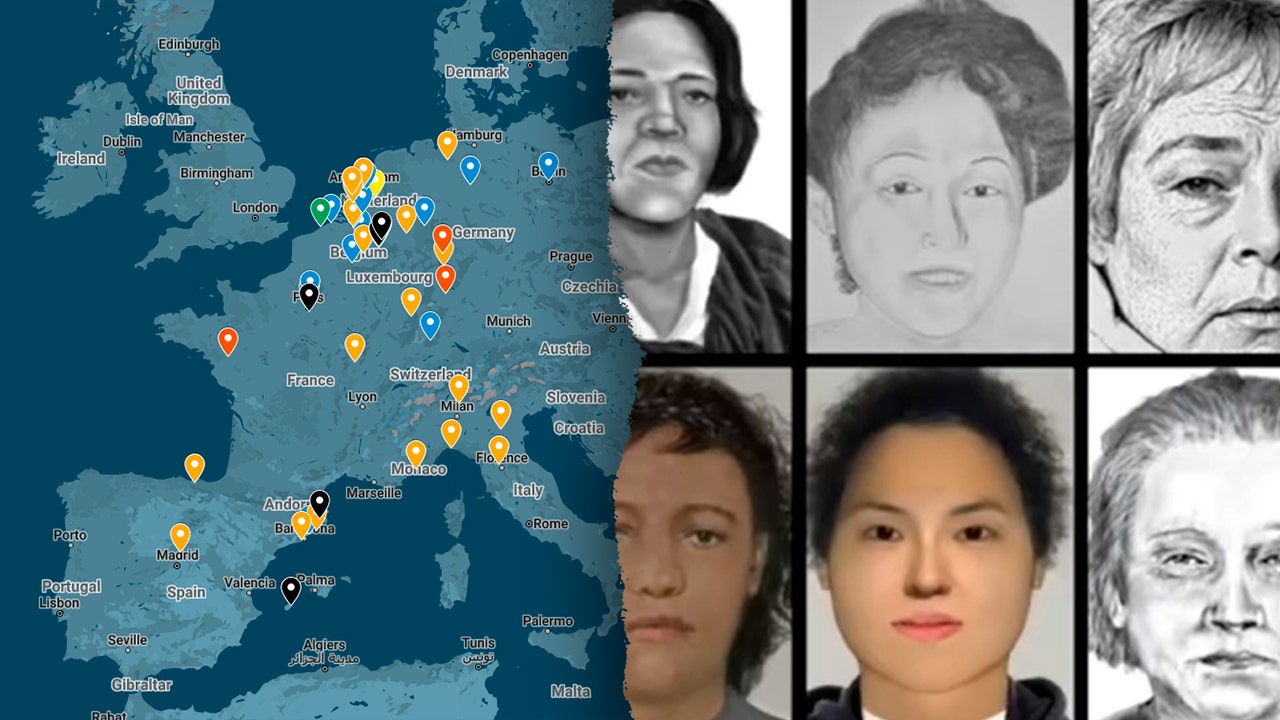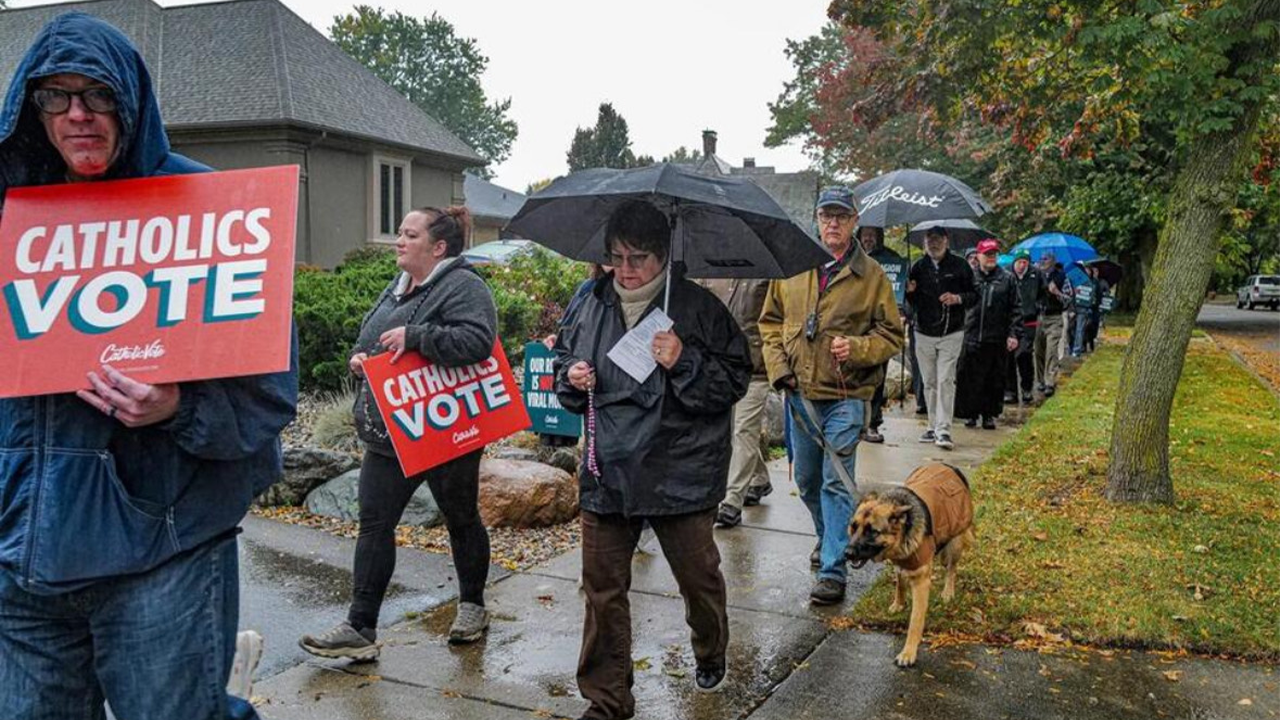Lifestyle
4 coffee table art books from 2023 that are a visual feast

Meghan Collins Sullivan/NPR

Meghan Collins Sullivan/NPR
There’s plenty of art to feast your eyes on in these four very different coffee table books.
Presented in reverse chronological order, we move back in time from Art is Art — a fabulous collection of outside-the-box work by more than 100 contemporary, neurodiverse artists — to Milton Glaser’s ’60s and 70’s pop graphics, Aino and Alvar Aalto’s iconic Finnish modernist designs, and a global survey of Islamic architecture through the centuries.
All are eye-opening (and would make great gifts, if you’re still looking).
Art is Art: Collaborating with Neurodiverse Artists at Creativity Explored

An oil pastel by Camille Holvoet as seen in Art Is Art.
Camille Holvoet/Chronicle Books
hide caption
toggle caption
Camille Holvoet/Chronicle Books
Art is Art is such a spirit lift. The nonprofit studio and gallery behind it, Creativity Explored, was founded in San Francisco in 1983 to partner with disabled, neurodiverse artists. Their mission is to encourage “fearless self-expression.” The images, saturated with strong colors and feelings, corroborate the group’s outlook: “Art is art, regardless of who makes it.”
The work, by about 130 artists and edited by Ann Kappes, is divided into 40 chapters highlighting themes that include superheroes, fears, sex, deafness, patterns, politics, collage art, and flowers. Every few chapters, an individual artist is showcased.
Two popular subjects are animals and dancing. Among the paintings featured in “A Curious Menagerie,” there’s a beguiling bloodhound and a mythical wild lion cat. In “Dance Party!” multiple artists capture the exuberance of letting go at the rhythm and movement sessions that mark the end of each work week at the studio. In “Medicine Helps,” the labels on Camille Holvoet’s colorful prescription bottles speak volumes: “Helps Me Not Ask for Money or Free Food,” reads one. “Anti-Emotional Confuzion,” reads another. Her vibrant celebratory cakes look like something you might find in a book by Maira Kalman.
Milton Glaser POP

An image made by Milton Glaser, as seen in Milton Gllaser: Pop.
Monacelli Press
hide caption
toggle caption
Monacelli Press
Milton Glaser POP, by Steven Heller, Mirko Ilic and Beth Kleber, explores the phenomenally prolific graphic designer’s pop era work, which spanned the 1960s and 1970s. It’s a period that includes his famous Bob Dylan poster, with the silhouetted singer topped with wavy ribbons of multi-colored hair. Flipping through this book, you’ll be inclined to agree with the authors that Glaser’s “collaborative virtuosity” with artist Seymour Chwast in their Push Pin Studio “did for illustration and graphic design what John Lennon and Paul McCartney did for pop music.”
Glaser’s posters, advertisements, record album covers, and book covers were ubiquitous. So, too, were his covers for New York magazine, which he co-founded with Clay Felker in 1968.
If you went to high school in the last 60 years, chances are that your introduction to Shakespeare was through Signet Classic paperback editions, whose covers feature Glaser’s distinctive ink sketches enhanced by pops of color. Most were under a dollar each when he created them in 1963. They’re still available, at least online, at $5.95 each. Glaser’s illustration of Antony and Cleopatra remains a standout, with the ill-fated lovers drawn in closely overlapped silhouettes, like a pair of ice dancers. Cleopatra’s colorful striped headdress and exotic eyeliner evoke Elizabeth Taylor in the 1963 film.
To execute all this work, Glaser (1929-2020) designed numerous whimsically named typefaces, including Babycurls, Babyfat, and Babyteeth. But he remains best known for his red-hearted I Love New York logo, created to encourage tourism when his native city was down and out in the late 1970s. It became a rallying cry after 9/11, and in its nearly 50 year existence, has spawned thousands of variations.
Aino + Alvar Aalto

Artek, first showroom, Helsinki, Finland, 1936, as pictured in Aino + Alvar Aalto.
Heinrich Iffland, Alvar Aalto Foundation /Phaidon
hide caption
toggle caption
Heinrich Iffland, Alvar Aalto Foundation /Phaidon
Heikki Aalto-Alanen’s illustrated biography of his grandparents, the 20th century Finnish architects and designers Aino and Alvar Aalto, makes clear how fundamental Aino was to their integrated vision.
In fact, Aino + Alvar Aalto is a love story, enriched not just by personal photographs and images of their modernist designs, but by the couple’s letters to each other.
The Aaltos both studied architecture at the Helsinki University of Technology. They married in 1924, and worked closely together until Aino’s death from breast cancer in 1949. Their dedication to a modernist aesthetic was shared from early on, whether they were designing large public commissions or their still-popular bentwood chairs and stools and undulating Aalto vases, which they created in the 1930s.
Heikki Aalto-Alanen and his mother Johanna discovered the couple’s private trove of letters while emptying the family’s Helsinki house after the death of Alvar’s second wife in 1994. (Alvar died in 1976.) The handwritten letters, addressed to “My dear little Aino” and “Dear little Alvar,” written while Alvar was away on business, were filled with a mix of family news and updates about their work. (Aino stayed in Helsinki with their two children and supervised local projects.)
Unfortunately, the couple’s heavily quoted correspondence is printed in a faint font on blue paper, which is hard on the eyes. Fortunately, that’s not the case with the images of their work or the photographs of the Aaltos at home, on the job, and in their travels as ambassadors of modern Finnish design.
Not to be missed is a multi-page spread featuring a relatively early project, the Tuberculosis Sanatorium at Paimio, in southwestern Finland. With an alluring, undulating façade and deep sun terraces built to maximize sunlight and fresh air for its patients, its interiors are furnished with Aalto designs, including the beds, the wash basins tilted to a 45 degree angle to minimize noise and splashes, and the sinuously bent birch plywood Paimio armchairs, whose back was angled at 110 degrees to help sitters breathe more easily. The much-coveted Paimio Armchairs have been in continuous production for 90 years.
Islamic Architecture: A World History

Chapel of Thanksgiving at Thanks-Giving Square in Dallas, Texas (1976) as seen in Islamic Architecture: A World History by Eric Broug.
Carol M. Highsmith /Thames & Hudson/© Library of Congress
hide caption
toggle caption
Carol M. Highsmith /Thames & Hudson/© Library of Congress
Eric Broug’s richly illustrated history, Islamic Architecture, spans 1,400 years and the entire globe. Organized into six geographic regions, it offers graphic proof of Islam’s “immense global richness and diversity.”
Broug’s criteria for inclusion are “beauty, visual interest and relevance.” By juxtaposing an Umayyad mosque in Damascus, Syria dating back to 715 CE with a prayer space in the King Abdullah Petroleum Studies and Research Center in Riyadh, Saudi Arabia, designed by Zaha Hadid in 2017, he underscores his point that not all noteworthy Islamic architecture is ancient.
Other modern standouts include starchitect Jean Nouvel’s Louvre Abu Dhabi, also dating from 2017, and the Museum of Islamic Art in Doha, Qatar, designed by I.M. Pei at age 90 and built in 2008 on an artificial peninsula in Doha Bay. Also built in 2017, Kashef Chowdhury’s seven-story cast concrete mosque in Dhaka, Bangladesh, designed vertically to fit more worshippers on its small site, looks like an office building from the outside.
If some mosques look like corporate headquarters, the Yenidze Tobacco and Cigarette Factory in Dresden, Germany was built in 1909 to look like a domed mosque. That’s because in 1909 it was forbidden to build factories in Dresden that looked like factories. The minaret is actually the factory’s chimney. Damaged by airstrikes in 1945, it was restored after German re-unification in 1990, and has been converted into an office building.
Much better known but by no means the most beautiful mosque in this book is the Taj Mahal, built in Agra, India in the 17th century. Many of the most significant monuments of Islamic architecture were built in 10th and 13th century Iran, including the richly patterned Friday Mosque of Yazd, Iran, with its two tall minarets and arched, blue-tiled entrance. Strikingly different is the Great Mosque of Djenné, Mali, dating from the 13th century. It is the largest free-standing structure of mud-brick and clay-plaster in the world. Another curiosity — in this book full of treasures and surprises — is the late 19th century Arab room in Cardiff Castle, Wales, whose entire niched ceiling is covered in real gold leaf.

Lifestyle
Sunday Puzzle: The 'Pits' puzzle

Sunday Puzzle
NPR
hide caption
toggle caption
NPR
On-air challenge: Today’s puzzle is called “The Pits.” Every answer is a familiar two-word phrase or name in which the first word starts PI- and the second word starts with T-.
Ex. Jewelry and precious metals in a hidden chest –> Pirate Treasure
- Where to sit for a meal at a park
- Light to moderate-size vehicle for hauling supplies
- Intimate conversation in bed
- Person who repairs a baby grand, for example
- Large part of an old television on which the image appears
- Physical condition in which the ends of the feet point inward
- Symbol of Maine that’s shown on the state flag
- Prime minister of Canada in the 1960s, ’70s, and ’80s (and father of the current P.M.)
- Sausage, pepperoni, and mushrooms are the most common ones
- Loose leaves that are packed into a small bowl and smoked
- Colored geometric shape that’s a symbol for gay rights
Last week’s challenge: Last week’s challenge comes from listener Joe Krozel, of Creve Coeur, Mo. Think of a place in America. Two words, 10 letters altogether. The first five letters read the same forward and backward. The last five letters spell something found in the body. What place is this?
Challenge answer: New England
Winner: Bob Jahn of Blue Mounds, Wisconsin.
This week’s challenge: This week’s challenge comes from listener Mike Selinker, of Renton, Wash. Think of something to drink whose name is a compound word. Delete the first letter of the first part and you’ll get some athletes. Delete the first letter of the second part and you’ll get where these athletes compete. What words are these?
Submit Your Answer
If you know the answer to the challenge, submit it here by Thursday, October 17th, 2024 at 3 p.m. ET. Listeners whose answers are selected win a chance to play the on-air puzzle. Important: include a phone number where we can reach you.
Lifestyle
Gypsy Rose Recommends Menendez Bros Get Therapy If Released From Prison

BACKGRID
Gypsy Rose Blanchard has some advice for the Menendez Brothers … saying the outside world is so different — and, a good therapist goes a long way.
We caught up with Gyspy at LAX Sunday … and, we had to ask her about the Erik and Lyle Menendez who are serving life sentences for murdering their parents — though their case is receiving renewed attention over evidence supporting the claims their dad sexually abused them.
GRB — who was sentenced to 10 years in jail for second-degree murder of her mother, Dee Dee Blanchard, who abused her — says she’s not super educated on the intricacies of the Menendez case … but, she stands for all victims of abuse.
She says abuse victims need to be advocated for more and prisons need to be reformed … and, she hopes something can be done if Erik and Lyle were abused.
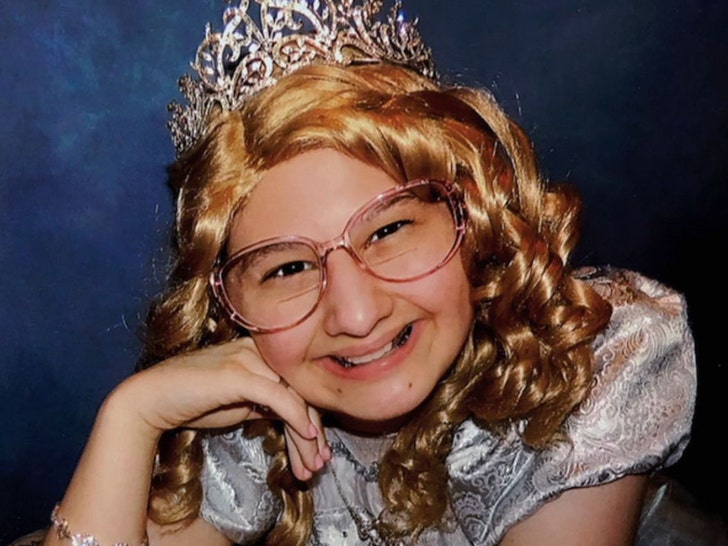
When told Kim Kardashian‘s supporting Erik and Lyle, Gypsy calls the reality star and mogul “a wise woman” … and applauds her for her prison reform work.
As for her advice for the Menendezs … she says the world is so different now, it can be hard to adjust. She recommends getting into therapy to help adjust to today’s day and age.
TMZ.com

The Los Angeles County D.A. is looking over the Menendez case … after a member of the band Menudo accused Jose Menendez of sexual abuse, just like his kids did. The D.A. will make a determination about whether the brothers deserve a new trial or a shorter sentence soon.
In any case, sounds like Gypsy’s available to dispense advice if Erik and Lyle do get out.
Lifestyle
How one Afro-Colombian community honors their ancestry

Camilo Garcia peeks through a curtain of his house on the morning of March 29, 2024, in the town of Juntas, Buenaventura, Colombia. The community gathers during Holy Week to celebrate the Manacillos festival, an ancestral ritual originating in the upper part of the Yurumangui River.
Nathalia Angarita for NPR
hide caption
toggle caption
Nathalia Angarita for NPR
It’s Spy Wednesday, almost 6 a.m. At the shipyard port in Buenaventura, the major port city in Colombia’s Pacific region, the last wooden boats are about to depart for the Afro-Colombian communities along the Yurumanguí River.
Dozens of people embark on a journey that can last up to eight hours, crossing the Pacific Ocean, skirting cliffs and navigating through mangroves. Most passengers now live far from their native territory, displaced to the city due to economic instability, lack of health care access, education or the region’s armed conflict.
Upon reaching the clear waters of the Yurumanguí River, wooden houses begin to appear along its banks. There are 13 settlements in the river basin, home to approximately 4,000 residents, mostly descendants of enslaved Africans and maroons brought to work in the mines between the 17th and 19th centuries.
In a context of geographic isolation and state neglect, where illegal armed groups have a substantial presence, the Afro community of Yurumanguí comes together despite intimidations to celebrate the Manacillos festival every Holy Week.
Far from tourists, this ancestral and unique ritual originated in Juntas, the uppermost village on the river, as an act of cultural resilience. During the festival, no one is allowed to work in the artisanal gold mines or the agricultural fields in the jungle.
In Juntas, the memory of slavery is alive. The Manacillos hold profound spiritual significance, reaffirming their African roots and resisting colonialism and imposed Catholicism through syncretism, creating a new collective cultural identity.

A silhouette of an Afro-Colombian woman in her home, on the night of March 28, 2024, in the town of Juntas, Buenaventura, Colombia.
Nathalia Angarita for NPR
hide caption
toggle caption
Nathalia Angarita for NPR

People arrive in boats to the village located on the banks of the Yurumangui River on March 28, 2024, in Juntas, Buenaventura, Colombia.
Nathalia Angarita for NPR
hide caption
toggle caption
Nathalia Angarita for NPR
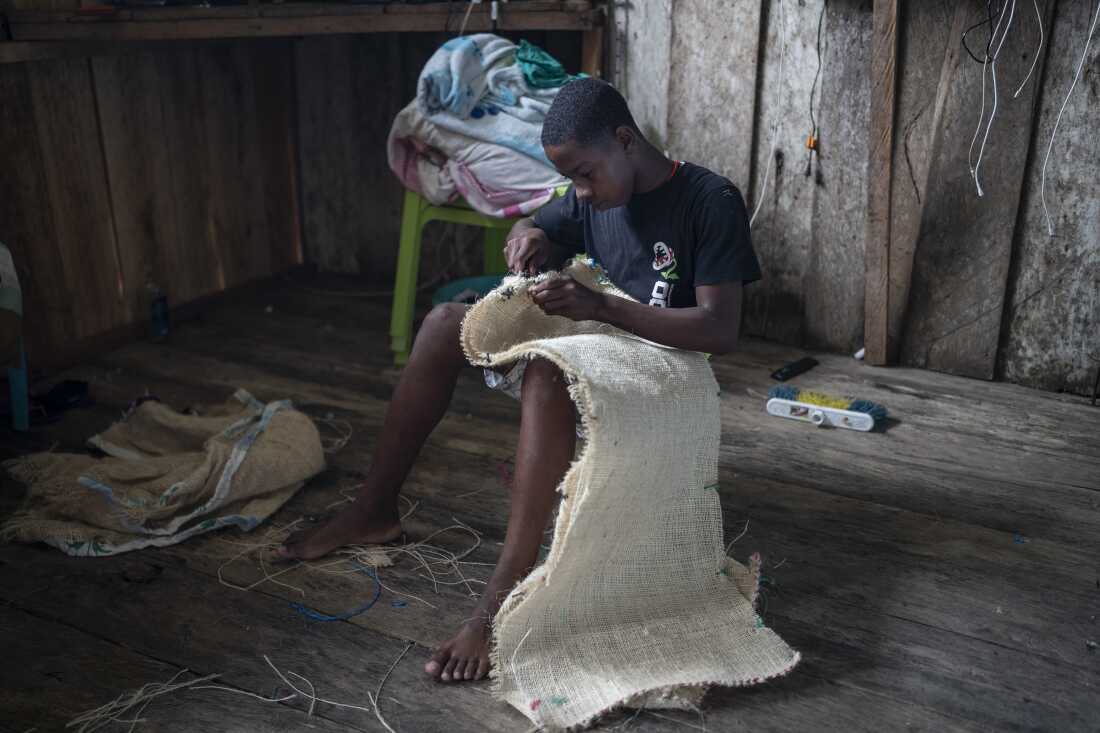
A boy designated to be one of the Manacillos sews his costume for Holy Week on March 29, 2024, in Juntas, Buenaventura, Colombia.
Nathalia Angarita for NPR
hide caption
toggle caption
Nathalia Angarita for NPR

Camilo Garcia on the morning of March 30, 2024, in the town of Juntas, Buenaventura, Colombia.
Nathalia Angarita for NPR
hide caption
toggle caption
Nathalia Angarita for NPR
Manacillos: Spiritual beings
It’s Maundy Thursday. The community has adorned the cobblestone streets and balconies with corozo palm leaves. Ayerson Valencia and Henry García finish sewing their Manacillos costumes with the help of female family members. Meanwhile, in the same room, some women braid their hair, paint their nails, and try on elegant dresses.
The typical Manacillo’s costume is made of burlap sacks and banana leaves and is often adorned with colorful fabric patches. Additionally, every Manacillo wears a slender leather whip fastened to their waist, which they use to “punish” the other participants during the Manacillos’ games.
Along with this, the rest of the costume consists of a distinctive and colorful mask carved from balsa wood sourced within their own jungle. In the backyard of his house, 15-year-old Henry applies the final touches to his mask, painting a red smile reminiscent of the Joker’s.
The masks of the Manacillos transform the wearer into spiritual beings. “Every year, we decide what type of mask to paint, reflecting how we want to be perceived. Some evoke fear, others are humorous,” he says.
Meanwhile, some men are completing the construction of the Manacillos’ house, a small wooden structure located in the center of the village that faces the church. Here, the group gathers to play traditional Manacillo songs, recharge with viche — a traditional alcoholic beverage of the Afro-Pacific communities — and plan their next activities. During the Manacillos’ game, they attempt to steal Jesus’ coffin, play pranks, tease passersby, steal objects and even “kidnap” locals, including babies, for ransom.
There is no age limit to become a Manacillo, as membership is inherited from parents by their sons or other close male relatives after they pass away. This year, the youngest member is 7-year-old Leandro Valencia, who inherited the role after his father, a leader in the community, died in exile. Over the next few days and nights, he plays his role tirelessly, just like a child.
Adolescents such as Henry, who has been playing the role for five years, feel a strong sense of pride: “I became a Manacillo to honor our ancestors and preserve our cultural heritage. My goal is to pass down this knowledge to the younger generation so that our traditions are not forgotten.”

People walk through the town in a procession while singing traditional songs at midnight on March 29, 2024, in Juntas, Buenaventura, Colombia.
Nathalia Angarita for NPR
hide caption
toggle caption
Nathalia Angarita for NPR

Women sing religious and ancestral songs during a Holy Week procession on March 29, 2024, in Juntas, Buenaventura, Colombia.
Nathalia Angarita for NPR
hide caption
toggle caption
Nathalia Angarita for NPR
Resistance through the traditional music
Holy Week is celebrated differently here. In their tradition, Jesus’ death occurs at midnight on Thursday, not on Good Friday. The ritual begins with a procession of Jesus the Nazarene and is repeated nightly until Easter Sunday. During this religious syncretism, the village is shrouded in darkness, illuminated only by candlelight.
The village catechist, Delio Valencia, and the altar boys chant prayers while carrying leaf-adorned statues of Jesus and his mother, Mary. Leading the procession, a group of women sing soulful and loud salves and alabaos — traditional Afro community songs for religious rituals and funerals to bid farewell to the deceased. Their bodies sway with the rhythm.
At the front of the crowd, Luz Damaris García, a 49-year-old vocalist, sings with a deep, raspy voice. Tears glisten in her eyes as she holds her friend’s arm. Both sway gently, harmonizing the lyrics and melody. “The salve is like a feeling. It reminds us of those who have departed,” she says.
That night, the ceremonial procession visits the local cemetery, where three solitary souls, portrayed by trembling men in white sheets, descend from the sacred heights. Children hold their mothers’ hands tightly, some crying, others laughing. They will sing their unique religious songs in the church until 4 a.m. The Manacillos will not appear until the next day.
The main outer wall of the church is adorned with a large painting of the last two social leaders who disappeared at the hands of armed groups. The painting includes the phrase, “We will die on the day we remain silent in the face of injustices.”
One of the leaders was 79-year-old Delio’s son. “During prayers, we always entrust ourselves to them, who lost their lives to free the Yurumanguí River and liberate their people,” he says.

People dress up as souls in purgatory coming down from the cemetery at midnight on March 29, 2024, in the town of Juntas, Buenaventura, Colombia.
Nathalia Angarita for NPR
hide caption
toggle caption
Nathalia Angarita for NPR

The Manacillos make a representation of the Pharisee soldiers who collaborated with the death of Jesus Christ, dressed in local tree leaves and colorful wooden masks, on March 29, 2024, in the town of Juntas, Buenaventura, Colombia.
Nathalia Angarita for NPR
hide caption
toggle caption
Nathalia Angarita for NPR

A person dressed as a Manacillo rests during a celebration on March 29, 2024, in the town of Juntas, Buenaventura, Colombia.
Nathalia Angarita for NPR
hide caption
toggle caption
Nathalia Angarita for NPR

The Manacillos make a representation of the Pharisee soldiers who collaborated with the death of Jesus Christ, dressed in local tree leaves and colorful wooden masks, at midnight on March 29, 2024, in the town of Juntas, Buenaventura, Colombia.
Nathalia Angarita for NPR
hide caption
toggle caption
Nathalia Angarita for NPR
The rules of the Manacillos’ game
Originally, the Manacillos’ ritual commemorated the passion, death and resurrection of Christ in their unique way. The group started with 12 men led by a Manacillo named Barrabás, after the Biblical figure, and has now grown to nearly 40. According to oral tradition, the Manacillos are the spirits of the Jews who betrayed and executed Jesus.
The Manacillos’ play begins on Good Friday evening, and they are not allowed to sleep for the next 48 hours. Before singing, the masked men shout, “Death to God and long live Barrabás!” The rest of the community responds, “Long live God and death to Barrabás!”
The celebration begins with the drumbeat. A woman initiates a melodic chant: “On Holy Thursday, God died; on Friday, they buried him; on Saturday, they sang his glory; on Sunday, he ascended to heaven.” Other musicians join in with traditional instruments — bass drum, cununo and guasá, which sounds like water. The song is repeated several times.
Everyone is covered in sweat, the musicians seeming to merge with their instruments. The female singers and other participants repeat the song without showing signs of fatigue, their voices full of emotion. The music creates a mystical trance and euphoria among the participants. No other music is allowed until Easter Sunday; otherwise, the Manacillos will punish the offenders with whips.
Over the next few days, the entire community gathers in Juntas, captivated by the nocturnal warmth and viche spirits. Amid this fervor, the game’s characters dance, leaping from side to side, holding their attires. The youngest members of the community move from house to house, singing in honor of the Manacillos.
“Music helps us preserve our identity amid the armed conflict. Today, many children prefer picking up an instrument over a weapon,” explains Franklin Valencia, an instrumental musician from the popular group Matachindé.

A person holds a gold necklace with the image of Jesus Christ on March 29, 2024, in the town of Juntas, Buenaventura, Colombia.
Nathalia Angarita for NPR
hide caption
toggle caption
Nathalia Angarita for NPR

A child dresses up as a Manacillo on March 30, 2024, in the town of Juntas, Buenaventura, Colombia.
Nathalia Angarita for NPR
hide caption
toggle caption
Nathalia Angarita for NPR
More than daily violence
During the Manacillos’ dramatization, violent scenes occur as they are allowed to punish locals and vice versa. Many suggest that beneath the Manacillos’ masks are community members affiliated with armed groups. These individuals get permission from their superiors during Holy Week to play the role before returning to the wilderness.
The festival enables improbable encounters in daily life. Civilians and soldiers from different armed groups come together in the same space without violence. Solange Bonilla Valencia, a Ph.D. student in social anthropology and a specialist in peace, culture and international humanitarian law, explains that in the tense conflict of Yurumanguí’s river communities, violence takes on a spiritual dimension — a collective release.
“It’s a moment of catharsis, a chance to encounter the other. The fear of being struck with a whip is different from the fear of being killed with a firearm,” she says.
Amid the exuberant nature along the banks of the Yurumanguí River, prominent signs bearing the insignias and messages of the Jaime Martínez Group, an illegal armed faction of the demobilized guerrilla Revolutionary Armed Forces of Colombia (FARC), appear every few kilometers upstream. The dissident group displays its presence and activity in the territory. The ever-present, yet hidden, eyes that intimidate the inhabitants.
The conflict among armed groups for control over this territory has intensified due to its strategic location for drug trafficking. The celebration has changed, and there is fear of losing ancestral traditions. “Many former Manacillos can no longer participate,” Angulo explains. “Some were killed, others relocated due to insecurity.”
Angulo, a 60-year-old human rights defender and active Manacillos leader who is identified only by his last name for his safety, as he plans on returning for future celebrations, spent several years away from his homeland due to the threats posed by the armed groups. Now, he is enthusiastic about the significant number of community members who have returned for the four-day celebration.
The Manacillos’ festival is not only a moment of joy and a break from routine but also a time to remember deceased relatives, return to the territory and reinforce social ties. “I was raised in this jungle and then forced to leave, abandoning my children and traditions,” he says. “That had a profound impact on me. Here, I feel good. I’m not a city man.”
In late November 2021, two prominent social leaders, Abencio Caicedo and Edinson Valencia, were kidnapped by armed groups, plunging the community into distress and fear. Even the popular Manacillos festival was temporarily silenced by the residents’ grief.
“The loss of a leader is a huge pain. Many have been killed, the most important leaders are lost, and we are left unprotected,” says Luz Damary.

People carry religious representations while walking on the Manacillos on March 31, 2024, in the town of Juntas, Buenaventura, Colombia.
Nathalia Angarita for NPR
hide caption
toggle caption
Nathalia Angarita for NPR

People carry religious representations while walking on the Manacillos on March 31, 2024, in the town of Juntas, Buenaventura, Colombia.
Nathalia Angarita for NPR
hide caption
toggle caption
Nathalia Angarita for NPR

Children disguised as Manacillos in the Yurumangui River on March 31, 2024, in Juntas, Buenaventura, Colombia.
Nathalia Angarita for NPR
hide caption
toggle caption
Nathalia Angarita for NPR

A person wears a Manacillo costume representing the Pharisee soldiers who collaborated with the death of Jesus Christ, on March 31, 2024, in the town of Juntas, Buenaventura, Colombia.
Nathalia Angarita for NPR
hide caption
toggle caption
Nathalia Angarita for NPR
The Yurumanguí River as a living entity
For the Yurumanguireños, the river is a living entity and an essential part of their community. Daily life revolves around its waters. Children learn to swim before they can speak. Women wash clothes and kitchen utensils in the river, which also serves as a natural shower and the main route for transporting wood, fish and fruits. The crystalline waters are surrounded by a lush, dense jungle that conceals sugarcane, plantain and corn fields, their primary sources of sustenance.
“Their primary concern is to safeguard the territory for future generations,” Bonilla explains. “They emphasize the vital role of a thriving, preserved river in sustaining life. They warn that neglecting the river, especially through heavy machinery in gold mining, would deprive future generations of the essence of life itself.”
“The river is life,” the inhabitants of Juntas reiterate when asked about its significance. The sentiment is evident in their efforts to protect the river from external threats, a struggle that has claimed the lives of several social leaders.
It’s Easter Sunday. After three sleepless nights, few seem tired. Once the rain stops, the Manacillos and the rest of the community — this time without the elderly or the children — march toward one of the river’s beaches. Despite the previous night’s alcohol, they skillfully cross the river. Some dive into the water while others fall asleep on the shore.
During the parade, the sound of the Manacillos’ songs resonates continuously, and everyone dances in ecstasy. This time, a few women, known as Manacillas, join them. Dressed in banana leaves and wearing straw hats adorned with colorful strips of plastic, they play their role while smoking prominent tobacco leaf cigars.
“Wearing the Manacilla attire brings me joy and fulfillment, connecting me deeply with memories of my grandmother,” says 18-year-old Manacilla Camila García Valencia. “I am honored to uphold her legacy.”
The procession returns to the village, where children and the elderly gather around the church, dressed in their best clothes. As Jesus rises from the dead, the Manacillos throw themselves to the ground, acknowledging his resurrection. Now, they are believers.
Once inside the church, everyone dances to the rhythm of drums and bells. After several minutes, the instruments fall silent and the Manacillos retreat into the mystic world. Those behind the masks return to being ordinary people. The game between life and death ends in the ritual, but not in real life. “We are free here,” Angulo says. “Look at the river! We just want more security in our territory.”

The community gathers at the river on the last on the last day of Holy Week on March 31, 2024, in the town of Juntas, Buenaventura, Colombia.
Nathalia Angarita for NPR
hide caption
toggle caption
Nathalia Angarita for NPR
Nathalia Angarita is a documentary photographer and Marina Sardiña is a reporter, both are based in Bogotá, Colombia. You can see more of their work on instagram at @nathalianph and @marina_sardina
-

 Health1 week ago
Health1 week agoHealth, happiness and helping others are vital parts of free and responsible society, Founding Fathers taught
-

 Sports1 week ago
Sports1 week agoFreddie Freeman says his ankle sprain is worst injury he's ever tried to play through
-

 News1 week ago
News1 week agoLebanon says 50 medics killed in past three days as Israel extends its bombardment
-
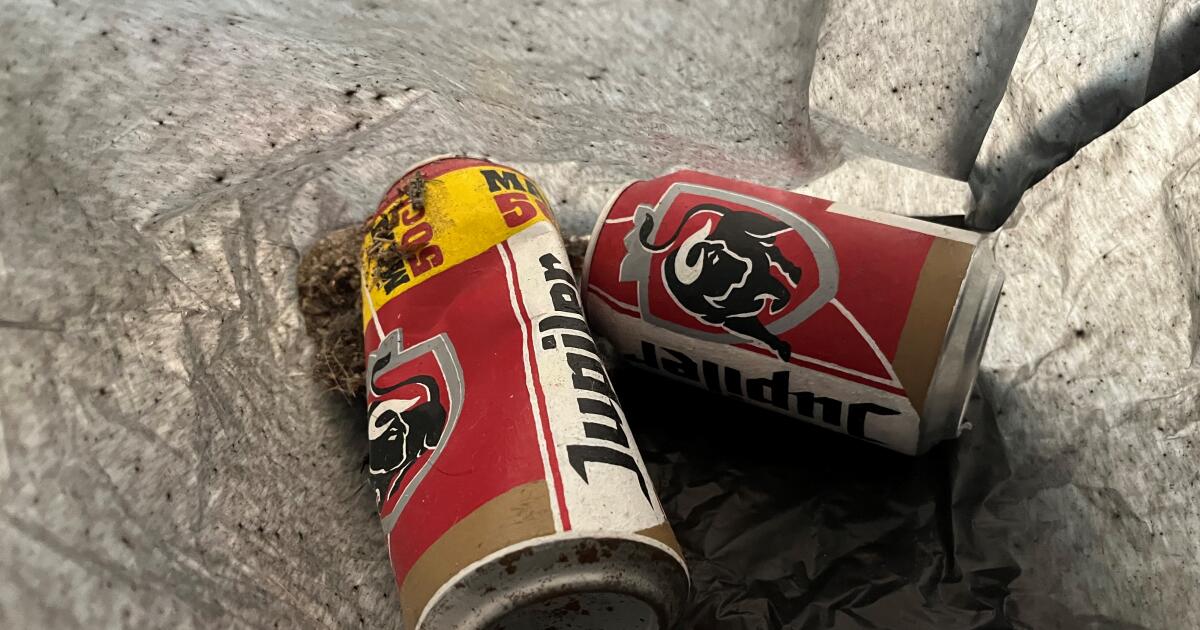
 Entertainment4 days ago
Entertainment4 days agoHold my beer can: Museum says a worker thought unique art installation was trash
-

 Entertainment5 days ago
Entertainment5 days ago'The Office' star Jenna Fischer reveals private breast cancer battle: 'I am cancer free'
-
/cdn.vox-cdn.com/uploads/chorus_asset/file/25673932/462754179_560996103109958_6880455562272353471_n.jpg)
/cdn.vox-cdn.com/uploads/chorus_asset/file/25673932/462754179_560996103109958_6880455562272353471_n.jpg) Technology2 days ago
Technology2 days agoMeta suggests AI Northern Lights pics are as good as the real thing
-

 Technology4 days ago
Technology4 days agoScammers exploit grief with fake funeral streaming on Facebook
-
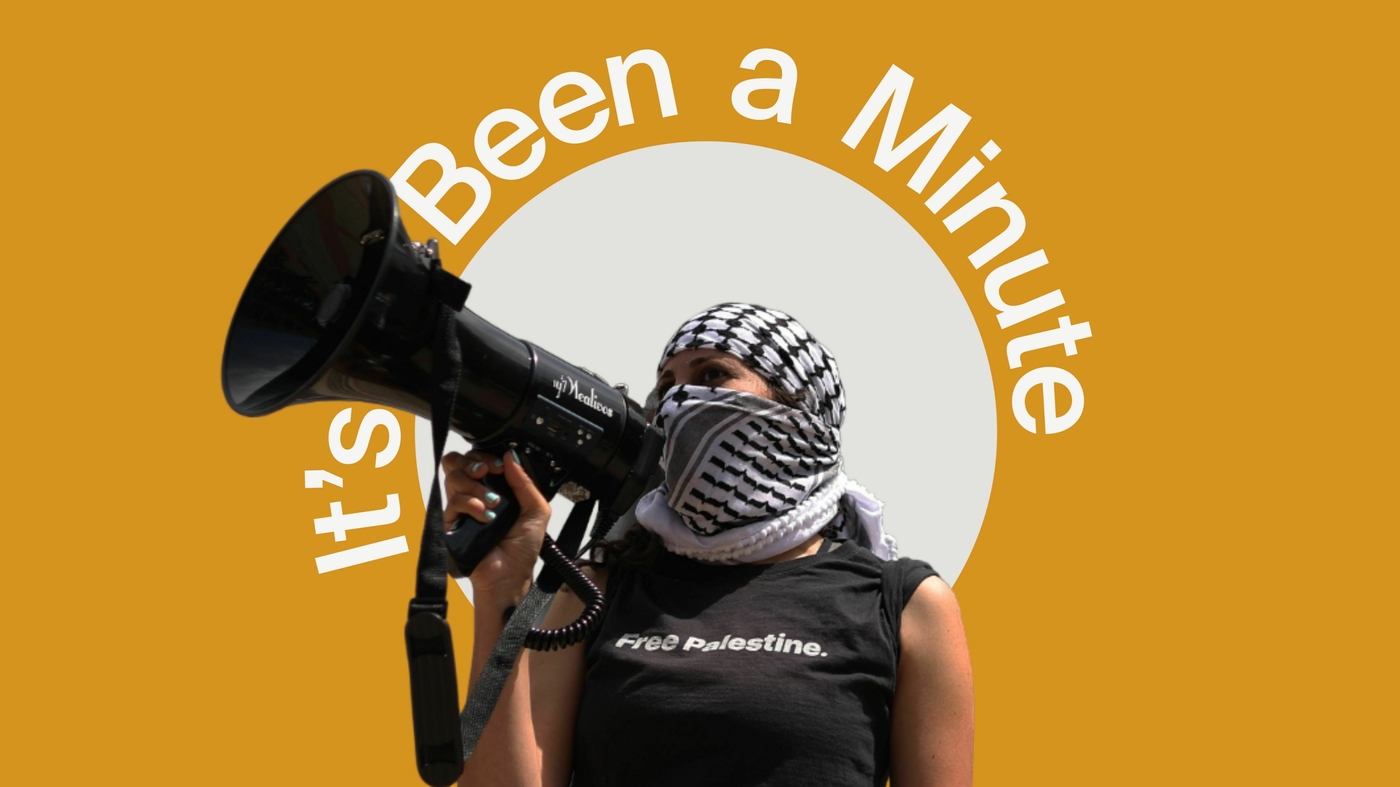
 Lifestyle24 hours ago
Lifestyle24 hours agoIs the free speech debate dead? Plus, the devil! : It's Been a Minute



/cdn.vox-cdn.com/uploads/chorus_asset/file/24090219/STK171_VRG_Illo_13_Normand_ElonMusk_13.jpg)
